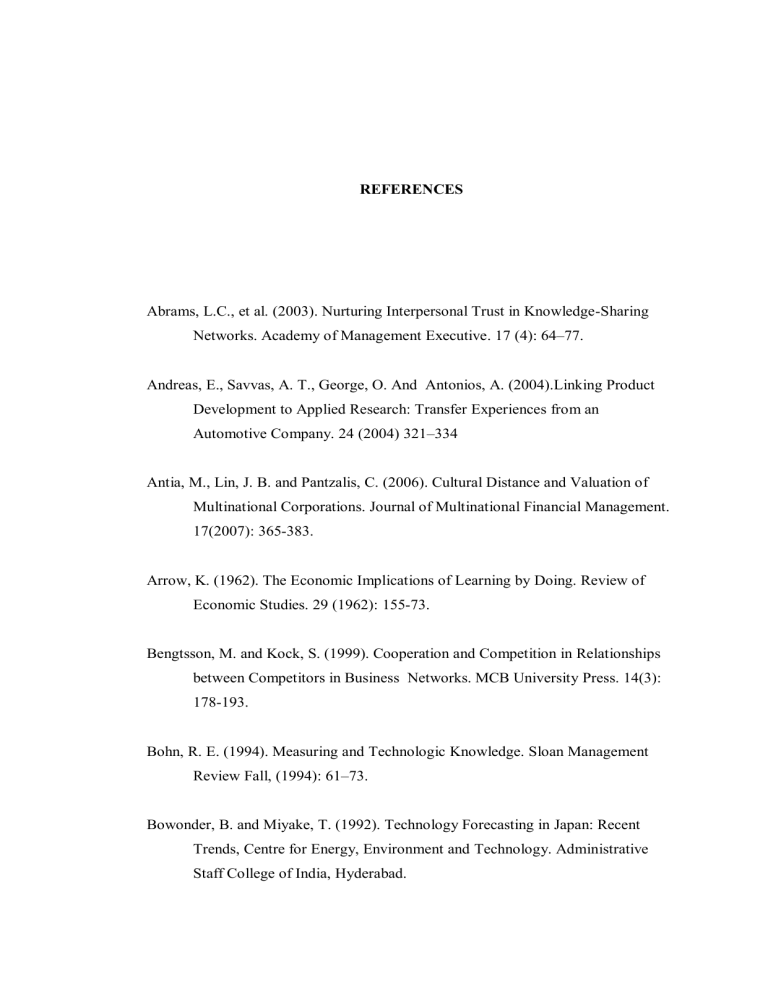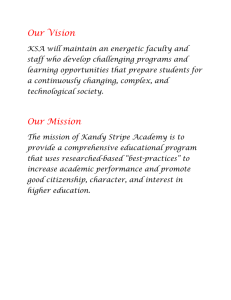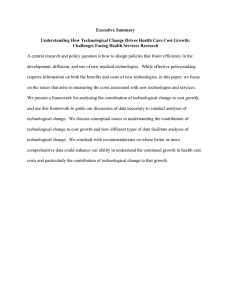Abrams, L.C., et al. (2003). Nurturing Interpersonal Trust in Knowledge-Sharing REFERENCES
advertisement

REFERENCES Abrams, L.C., et al. (2003). Nurturing Interpersonal Trust in Knowledge-Sharing Networks. Academy of Management Executive. 17 (4): 64–77. Andreas, E., Savvas, A. T., George, O. And Antonios, A. (2004).Linking Product Development to Applied Research: Transfer Experiences from an Automotive Company. 24 (2004) 321–334 Antia, M., Lin, J. B. and Pantzalis, C. (2006). Cultural Distance and Valuation of Multinational Corporations. Journal of Multinational Financial Management. 17(2007): 365-383. Arrow, K. (1962). The Economic Implications of Learning by Doing. Review of Economic Studies. 29 (1962): 155-73. Bengtsson, M. and Kock, S. (1999). Cooperation and Competition in Relationships between Competitors in Business Networks. MCB University Press. 14(3): 178-193. Bohn, R. E. (1994). Measuring and Technologic Knowledge. Sloan Management Review Fall, (1994): 61–73. Bowonder, B. and Miyake, T. (1992). Technology Forecasting in Japan: Recent Trends, Centre for Energy, Environment and Technology. Administrative Staff College of India, Hyderabad. 86 Bruun, P. (1995). Case Study of Productivity and Quality Aspect in Production Technology Transfer to China. International Journal of Production Economics. 41(1995): 109-114 Buckley, P. J., & Casson, M. (1996). An Economic Model of International Joint Venture Strategy. Journal of International Business Studies. 27(5): 849–875. Chakrabarti, A.K., Rubenstein, A.H. (1976). Interorganizational Transfer of Technology: A study of Adoption of NASA Innovations. IEEE Transactions on Engineering Management. 23(1976): 20-34 Chen, X. and Sun, C. (2000). Technology Transfer to China: Alliances of Chinese Enterprises with Western Technology Exporters. Journal of Technovation. 20 (2000): 353–362. Churchill, G. A. Jr. and Brown, T. J. (2004). Basic Marketing Research. USA: Thomson South-Western. Cohen, W.M. and Levinthal, D.A. (1990). Absorptive Capacity: A New Perspective on Learning and Innovation. Administrative Science Quarterly. 35(1): 128-52. Cui, A. S., Griffith, D. A., Cavusgil, S. T. and Dabic, M. (2006). The Influence of Market and Cultural Environmental Factors on Technology Transfer between foreign MNCs and Local Subsidiaries: A Croatian Illustration. Journal of World Business 41 (2006): 100–111 Cummings, J. N. and Kiesler, S. (2007). Coordination Costs and Project outcomes in Multi- University Collaborations. Research Policy. 36(2007): 1620-1634. Cusumano, M. A. and Elenkov, D. (1994). Linking International Technology Transfer with Strategy and Management: A literature Commentary. Research Policy. 23(1994): 195-215. 87 Cutler, R. S. (1989). A Comparison of Japanese and U.S. High Technology Transfer Practices. Interfaces. 19(1989): 67-77 Daghfous, A. (2004). Investigation of the Roles of Prior Knowledge and Learning Activities in Technology Transfer. Journal of Technovation. 24(2004): 939953 Davenport, T. H. and Prusak, L. (2000). Working Knowledge: Hoe Organizations Manage what they Know. Harvard Buisness School Press.Boston. MA Dodgson, M. (1992b). The strategic management of R&D collaboration. Technology Analysis & Strategic Management, 4(3): 227-244. Dosi, G. (1988). Sources, Procedures and Microeconomics Effects of Innovation. Journal of Economic Literature. 26(1988): 1120-71. Dyer, J. H. (1997). Effective Inter-firm Collaboration: How Firms Minimize Transaction Costs and Maximize Transaction Value. Strategies Management Journal. 18(1997): 535-556 Ecenson, R. (1976). International Transmission of Technology in Production of Sugar Cane. Journal of Development Studies. 1(1976): 1-13. Echols, A., Tsai, W., (2005). Niche and Performance: The Moderating Role of Network Embeddedness. Strategic Management Journal. 26 (3): 219–238. Eden, L., and Miller, S. R. (2004). Distance Matters: Liability of Foreignness, Institutional Distance and Ownership Strategy. New York: Elsevier. 187–221. Garvin, D.A. (1993). Building a learning organization. Harvard Business Review. Jul-Aug, 78–91. Gaynor, G.H. (1996). Handbook of Technology Management. (1st Edition). McGraw-Hill: New York, NY. 88 Grant, R.M. (1996). Toward a Knowledge-based Theory of the Firm. Strategic Management Journal. 17(1996): 109-22. Gulati, R., 1995. Does Familiarity Breed Trust? The Implications of Repeated Ties for Contractual Choice in Alliance. Academy of Management Journal. 38(1995): 85–112. Iansiti, M. (1995b). Technology Integration: Managing Technological Evolution in a Complex Environment. Research Policy 24(1995b):521–542 Janssens, M. and Brett, J. M. (2006). Cultural Intelligence in Global Teams: A Fusion Model of Collaboration. Group & Organization Management. 31(2006): 124–153 Jian, C. G., Chiu, K. M., Yam, C. M., Chin, K. S. and Kit, F. P. (2006). Technology Transfer and Innovation Performance: Evidence from Chinese Firms. Technological Forecasting and Social Change. 73 (2006): 666-678. Kanfer, F. H. and Karoly, P. (1972). Self-control: A Behavioristic Excursion into the Lion's Den. Behavior Therapy 3(1972): 398-416. Katz, M. and Shapiro, C. (1986). Technology Adoption in the Presence of Network Externalities. Journal of Political Economy, 94(1986): 822-41. Kedia, B. L. and Bhagat, R. S. (1988). Cultural Constraits on Transfer of Technology across Nations: Implications for Research in International and Coparative Management. Academy of Management Review. 13(1988): 559-71. Keller, R. T. and Chinta, R. R. (1990). International Technology Transfer: Strategies for Success. Academy of Management. 4(2): 33-43 Kim, L. (1998). Criss Construction and Organizational Learning: Capability building in Catching-up at Hyundai Motor. Organization Science. 19(1998): 461-77 89 Kratzer, J., Leenders, R. A. J. and Engelen, J. M. L. (2004). A Delicate Managerial Challenge: How Cooperation and Integration Affect the Performance of NPD Teams. 10(1/2): 20-25. Kulwant, S. (1997). The Impact of Technological Complexity and Interfirm Cooperation on Buisness Survival . Academy of Management Journal. 40 (2):330-367 Lee, J. and Win, H. N. (2004). Technology Transfer between University Research Centers and Industry in Singapore. Journal of Technovation. 24 (2004) 433– 442 Lin, B. W. and Berg, D. (2001). Effects of Culture Difference on Technology Transfer Projects: An Empirical Study of Taiwanese Manufacturing Companies. International Journal of project Management. 19(2001): 287-297 Might, R. J. and Fischer, W. A. (1985). The Role of Structural factors in determining Project Management Success. IEEE Transactions On Engineering management. 32(1985): 71-7 Nelson, R. and Winter, S. (1982). An Evolutionary Theory of Economic Change. Belknap Press. Boston. MA. Nieto, M. (2004). Basic Propositions for the study of the Technological Innovation Process in the Firm. European Journal of Innovation Management. 7 (4): 314324 Nonaka, I. and Takeuchi, H. (1995). The Knowledge creating company: How Japanese companies create the Dynamics of Innovation. New York: Oxford University Press. Polanyi, M. (1966). The Tacit Dimension. Anchor Day Books. New York. 90 Rebentisch, E. S. and Ferretti, M. (1995). A Knowledge Asset- Based View of Technology Transfer in International Joint Venture. Journal of Engineering and Technology Management. 12(1995): 1-25 Reed, R. and DeFillippi, R.J. (1990). Casual Ambiguity, Barriers to Imitation, and Sustainable Competitive Advantage. Academy of Management Review, 15(1): 88-102. Robert, E. B. (1979). Stimulating Technological Innovation: Organization Approaches. Research Management. 22(6): 27-31. Robert, N. M., and Bruun, P (1998). Transferring World Class Production to Developing Countries: A Strategic Model. 56-57 (1998): 433-450 Robinson, R. D. (1991). International technology Communication in the Context of Corporate Strategic Decision Making. London: Taylor & Francis. Roger, E. (2003). The Diffusion of Innovation. (5th Edition). The Free Press: New York, NY. Rosenberg, N. (1982), Inside the Black Box: Technology and Economics. Cambridge University Press. London. Rosenberg, N. (1996). Uncertainty and Technological. Stanford University Press. Pp. 334-53. Rothwell, R. (1992). Successful Industrial Innovation: Critical Success Factors for the 1990s. R&D Management. 22(3): 221-39. Schmookler, J. (1962). Economic sources of inventive activity. (1st Edition) Penguin Books: Harmondsworth. Schumpeter, J.A. (1939). Business Cycles: A Theoretical, Historical and Statistical Analysis of the Capitalist Process, McGraw-Hill, New York, NY. 91 Shabbir, H. (1998). Technology Transfer Models across Cultures: Brunei- Japan Joint Ventures. International Journal of Social Economics. 25(6/7/8): 11891198 Shariq, S. Z. (1999). How does Knowledge transform as it is Transferred? Speculations on the possibility of a Cognitive Theory of Knowledgescapes. Journal of Knowledge Management. 3(4). Simatupang, T. M., Sandroto, I. V. and Lubis, S. B. H. (2004). A Coordination Analysis of the Creative Design Process. Business Process Management Journal. 10(4): 430-444. Simon. H. (1947). Adminstartive Behavior. (1st Edition) Macmillan: London. Spann, M. S., Adams, M., Sounder, E. (1995). Measures of Technology Transfer Effectiveness: Key Dimensions and Differences in their use by Sponsors, Developers and Adopters. IEEE Transactions on Engineering Management. 42(1995): 19-29 Spender, J.C. (1996). Making Knowledge the Basis of a Dynamic Theory of the Firm. Strategic Management Journal. 17(1996): 45-62. Stock, G. N. and Tatikonda, M. V. (2000). A Typology of Project-Level Technology Transfer Processes. Journal of Operational Management. 18(2000): 719-737 Stock, G. N. and Tatikonda, M. V. (2004). External Technology Integration in Product and Process Development. Journal of Operational Management. 24(2004): 642-665 Sung, T. K. (2007). Technology Transfer in the IT Industry: A Korean Perspective. Technological Forecasting & Social Change. 76(2009): 700-708 Teece, D. J., Pisano, G. and Shuen, A. (1997), Dynamic Capabilities and Strategic Management. Strategic Management Journal. 18(7): 509-33. 92 Twiss, B. (1995). Managing Technological Innovation. (1st Edition). Pitman Publishing: London. Tyre, M. J. and Hauptman, O. (2010). Effectiveness of Organization Responses to Technological Change in the Production Process. Organization Science. 3(3): 301-320. Utterback, J. and Abernathy, W. (1975). A Dynamic Model of Process and Product Innovation. Omega. 3(6): 639-56. Wang, X. M. and Zhou, X (1999). A New Strategy of Technology Transfer to China. International Journal of Operations & Production Management. 19 (5/6): 527537. Wei, L. (1995) International Technology Transfer and development of Technological capabilities: A Theoretical Framework. Technology in Society. 17(1995): 103-20 Wong, V., Shaw, V. and Sher, P. J. H. (1998). Technology Assimilation: The Case of Taiwanese Information. Industrial Marketing Management. 27(1998): 213– 227. Zahra, S. A., Sisodia, R., Das, S., 1994. Technology Choice within Competitive Strategy Types: A Conceptual Integration. International Journal of Technology Management 9(1994): 172–195.



